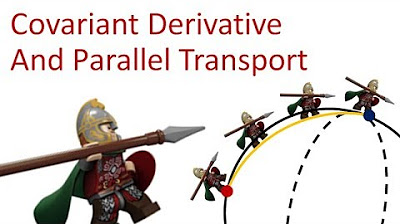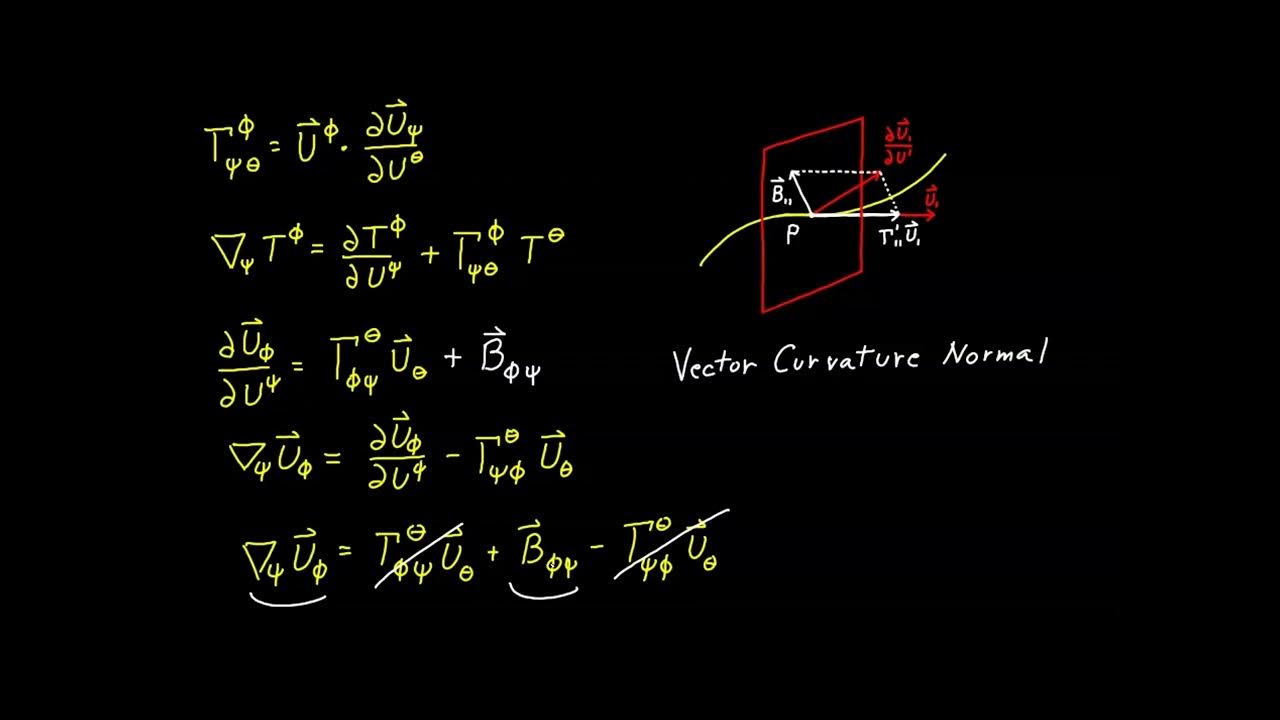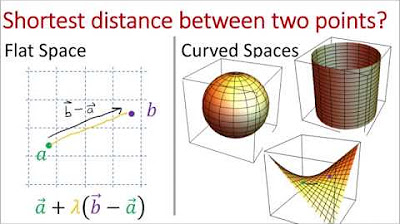Tensor Calculus 17: The Covariant Derivative (flat space)
TLDRThis video script delves into the concept of the covariant derivative, a fundamental tool for understanding vector field changes in the presence of varying basis vectors. It introduces the covariant derivative in flat space, contrasting it with geodesics and outlining four definitions, including the flat space, curved space extrinsic and intrinsic, and abstract definitions. The script provides a detailed exploration of derivatives in Cartesian and polar coordinates, emphasizing the importance of differentiating both vector components and basis vectors. It concludes by relating the covariant derivative to Christoffel symbols, highlighting its significance in flat space and setting the stage for further exploration on curved surfaces.
Takeaways
- 📚 The covariant derivative is a mathematical tool used to measure the rate of change of vector fields, taking into account the changing basis vectors.
- 🔗 The concepts of covariant derivatives and geodesics are closely related, and understanding one can enhance the understanding of the other.
- 📈 The video aims to explain the covariant derivative through four different definitions, increasing in complexity from the flat space definition to the abstract definition.
- 🌐 The flat space definition of the covariant derivative is the simplest and involves understanding the rate of change of vector fields in Cartesian and polar coordinate systems.
- 📉 In Cartesian coordinates, basis vectors are constant, leading to derivatives of a vector field being zero if the components are constant.
- 📈 In polar coordinates, basis vectors change with position, affecting the rate of change of vector fields even if their components are constant.
- 🔍 The script demonstrates the process of taking derivatives in both Cartesian and polar coordinates, highlighting the importance of differentiating both components and basis vectors.
- 📝 The multivariable chain rule and Einstein notation are used to simplify the expressions and calculations involved in understanding the covariant derivative.
- 📚 The covariant derivative in flat space is essentially the ordinary derivative, but with careful consideration of the basis vector changes.
- 📉 The Christoffel symbols, often used in more complex spaces, represent the rate of change of basis vectors and are introduced in the context of polar coordinates in flat space.
- 🔮 The video concludes by emphasizing that in flat space, the covariant derivative accounts for changes in both vector components and basis vectors, providing a foundation for understanding more complex spaces.
Q & A
What is the covariant derivative and why is it important?
-The covariant derivative is a mathematical tool used to understand the rate of change of vector fields, taking into account the changing basis vectors. It's important because it allows for the differentiation of tensors in a way that is consistent with the underlying geometry of space, which is crucial in general relativity and differential geometry.
How are geodesics related to the covariant derivative?
-Geodesics and the covariant derivative are highly related concepts. Geodesics are the shortest path between two points in a curved space, and the covariant derivative can be used to find the equations that describe geodesics by ensuring that the tangent vector to the geodesic has zero covariant derivative.
What are the different definitions of the covariant derivative mentioned in the script?
-The script mentions four different definitions of the covariant derivative: the flat space definition, the curved space extrinsic definition, the curved space intrinsic definition, and the abstract definition. These definitions form a 'staircase' of increasing complexity and generality.
Why might someone be confused about the covariant derivative when looking at different sources?
-Different sources may describe the covariant derivative in various ways, leading to confusion. The script suggests that understanding the covariant derivative requires seeing it from multiple perspectives, which can be challenging when each source presents a different approach.
What is the significance of basis vectors in the context of the covariant derivative?
-Basis vectors are crucial in the context of the covariant derivative because they define the local coordinate system in which the derivative is taken. The covariant derivative accounts for changes in these basis vectors as one moves through the space, which is essential for accurately describing how vector fields change.
How does the script simplify the understanding of basis vector derivatives in polar coordinates?
-The script simplifies the understanding of basis vector derivatives in polar coordinates by expanding the polar basis vectors in terms of Cartesian basis vectors and then deriving the rates of change for these basis vectors. This approach allows for a clearer visualization and comprehension of how the basis vectors change with respect to different coordinates.
What is the role of the Christoffel symbols in the context of the covariant derivative?
-Christoffel symbols are used to express the derivative of a basis vector with respect to another coordinate as a linear combination of the basis vectors. They capture the non-constant nature of the basis vectors in a particular coordinate system and are essential for calculating the covariant derivative in curved spaces.
How does the script illustrate the difference between a constant vector field and a vector field with constant components?
-The script uses an example of a vector field with components (2, 1) in Cartesian coordinates and another with components (R, 1) in polar coordinates. It shows that even though the components of the second vector field are constant, the field itself is not constant due to the changing basis vectors in polar coordinates.
What is the significance of the product rule in calculating the covariant derivative?
-The product rule is significant in calculating the covariant derivative because it allows for the differentiation of both the components of the vector field and the basis vectors. This ensures that the rate of change of the vector field is accurately captured, taking into account any changes in the basis vectors.
How does the script explain the concept of parallel transport using the covariant derivative?
-While the script does not explicitly explain parallel transport within the provided transcript, it sets the stage for understanding parallel transport by discussing how the covariant derivative accounts for changes in basis vectors. In the context of curved spaces, the covariant derivative can be used to define parallel transport, which is a way to move a vector along a path in a manner that keeps it 'parallel' according to the local geometry.
Outlines
📚 Introduction to Covariant Derivative in Flat Space
This paragraph introduces the concept of the covariant derivative in flat space, emphasizing its relation to geodesics and tensor fields. The covariant derivative is described as a tool for measuring the rate of change of vector fields, accounting for varying basis vectors. The video aims to clarify the covariant derivative's definition by presenting it through four different perspectives: flat space, curved space extrinsic, curved space intrinsic, and an abstract definition. The flat space definition is the simplest and is discussed first, with a reminder about Cartesian and polar coordinate systems and their basis vectors. The paragraph also touches on the Einstein notation and the multivariable chain rule for basis vector representation.
🌀 Understanding Vector Field Changes in Polar Coordinates
The second paragraph delves into the complexities of vector fields in polar coordinates, contrasting them with Cartesian coordinates. It explains that while a vector field with constant components might seem unchanging, the basis vectors in polar coordinates, \( \mathbf{e}_r \) and \( \mathbf{e}_\theta \), are not constant and thus can cause the vector field to change in length and direction. The paragraph outlines the process of taking the derivative of a vector field in polar coordinates, using the product rule to account for changes in both the components and the basis vectors. It also discusses the computation of basis vector derivatives, simplifying the process by expanding polar basis vectors in terms of Cartesian basis vectors and using the multivariable chain rule.
🔍 Deriving Basis Vector Derivatives in Polar Coordinates
This paragraph continues the discussion on the derivative of vector fields, focusing on the calculation of basis vector derivatives in polar coordinates. It provides a detailed mathematical derivation of these derivatives, including the conversion of Cartesian basis vectors to polar basis vectors and vice versa. The paragraph simplifies the expressions by factoring and applying trigonometric identities, leading to a clearer understanding of how the basis vectors change with respect to \( r \) and \( \theta \). It also offers an intuitive explanation of why the derivatives are structured as they are, relating to the physical interpretation of the basis vectors' behavior in polar coordinates.
🌐 Covariant Derivative in Flat Space and Christoffel Symbols
The final paragraph summarizes the concept of the covariant derivative in flat space, equating it to the ordinary derivative with careful differentiation of both vector components and basis vectors. It introduces the Christoffel symbols as a method to express the covariant derivative, particularly useful when dealing with basis vector derivatives. The paragraph contrasts the behavior of Christoffel symbols in Cartesian coordinates, where they all vanish due to constant basis vectors, with their non-zero values in polar coordinates, indicating the changing nature of the basis vectors. The summary concludes by emphasizing the importance of considering both component and basis vector changes when calculating the derivative of a vector field.
Mindmap
Keywords
💡Covariant Derivative
💡Geodesics
💡Flat Space
💡Basis Vectors
💡Product Rule
💡Christoffel Symbols
💡Einstein Notation
💡Polar Coordinates
💡Cartesian Coordinates
💡Tensor Fields
Highlights
Introduction to the covariant derivative in flat space, a tool for understanding the rate of change of vector fields considering changing basis vectors.
Relation between covariant derivative and geodesics as highly related concepts.
Plan to provide four different definitions of the covariant derivative in a stepwise manner.
Explanation of the flat space definition as the easiest and least powerful of the covariant derivative definitions.
Review of Cartesian and polar coordinate systems and their basis vectors as partial derivatives of a position vector.
Introduction of Einstein notation for simplifying expressions with summations.
Demonstration of how to calculate the derivative of a constant vector field in Cartesian coordinates.
Discussion on the misconception of a vector field being constant when its components are constant, using polar coordinates as an example.
Derivation of the rate of change of basis vectors in polar coordinates and their impact on vector fields.
Conversion of polar basis vectors to Cartesian basis vectors for easier computation of derivatives.
Simplification of the expressions for the derivatives of basis vectors in polar coordinates.
Intuitive explanation of the rates of change of basis vectors with respect to radial and angular coordinates.
Application of basis vector derivatives to calculate the derivative of a vector field in polar coordinates.
Clarification that a vector field with constant components does not necessarily mean a constant vector field.
Differentiation between the ordinary derivative and the covariant derivative in flat space.
Introduction of Christoffel symbols as coefficients in the linear combination of basis vector derivatives.
Explanation of how Christoffel symbols indicate changes in basis vectors and their role in the covariant derivative.
Summary of the covariant derivative in flat space as an ordinary derivative with proper differentiation of both vector components and basis vectors.
Teaser for the next video on the covariant derivative on curved surfaces and parallel transport.
Transcripts
Browse More Related Video

Tensor Calculus 18: Covariant Derivative (extrinsic) and Parallel Transport

Tensor Calculus 19: Covariant Derivative (Intrinsic) and Geodesics

Video 89 - Curve Projections

Tensor Calculus 15: Geodesics and Christoffel Symbols (extrinsic geometry)

Video 28 - Covariant Derivative for Contravariant Vector

Tensor Calculus Lecture 6c: The Covariant Derivative 2
5.0 / 5 (0 votes)
Thanks for rating: